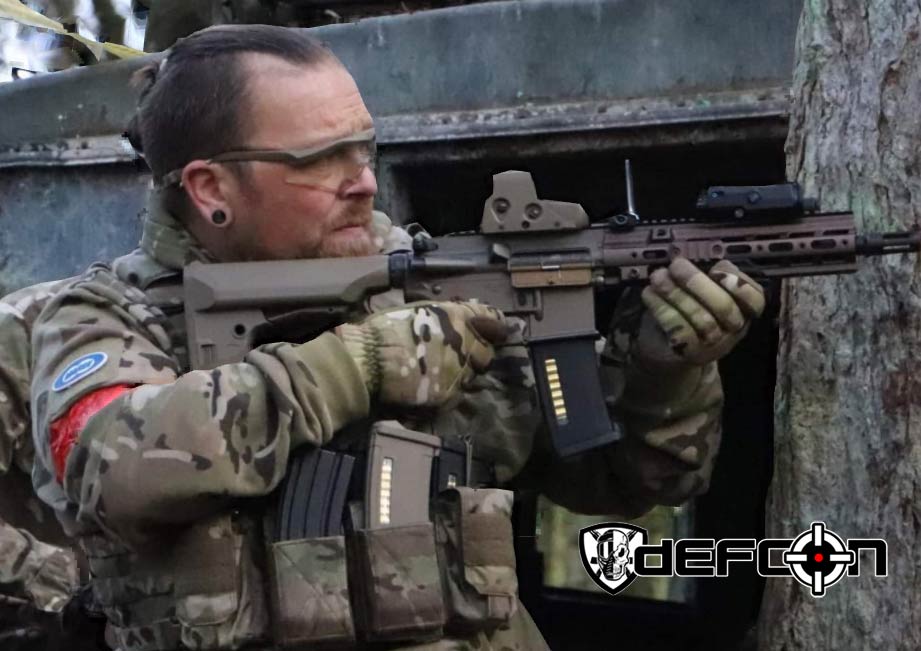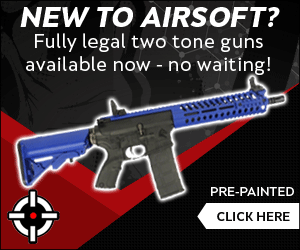Are you an Airsoft Skirmish Virgin? If so, please read on and we’ll help you be prepared for your first time:
Welcome to Your First Airsoft Game
What Happens Before the Airsoft Game Starts
You will be separated into teams and given a safety brief before the skirmish actually starts. Up until you enter the game zone, where eye protection is required, magazines will be kept off firearms (even pistols), and safeties will be activated. It is crucial that you pay great attention to the safety brief, which will also provide you a general sense of the site’s architecture and any advanced game rules (such as medical rules and respawns). The safety brief will also detail the scenario and any advanced game rules. There is nothing worse than spending a half-hour lost in the woods hunting for someone to kill because you were chin-wagging throughout the briefing. Trust me, I am aware! You don’t want to annoy these men since the more time you spend listening to the briefing again, the less time you have to engage in combat! There are however those tough marshalls who will stop the brief and start from the beginning every time they hear someone chatting.
How painful will being shot be?
If you’ve ever received a forceful pinch or flick, you know what to anticipate when being struck distantly or over clothing. Taking an Airsoft BB feels like being stung by a bee when you are very close to the target or on bare skin, but the pain lasts less than a second before it dulls. If you are concerned about having a few little marks here and there, wear protection because airsoft weapons can leave welts and marks on the skin. Many of you have probably played paintball before; the impact will hurt far less than a paintball marker. On the other hand, you will typically get hit multiple times because Airsoft Guns are much more accurate and fire at a higher rate than paintball markers. Despite the fact that paintball markers use frangible ammo, which shatter when it strikes you, airsoft is much safer because its permissible muzzle energy limitations are around 1/14th of those of the ordinary paintball marker. Being willing to absorb hits will offer you an advantage on the field, allowing you to be aggressive and strike the opposing force in a way they may not expect. If you are fearful of getting hit, it is necessary to get used to getting hit.
What should I wear?
While the utilisation of different terrain and frequently abandoned industrial buildings is a defining feature of airsoft and helps to make the experience as realistic as possible, it also poses risks for your feet if you aren’t careful. My suggested footwear would be respectable, cosy boots with ankle support. Since this is obviously very personal, you should wear whatever makes you feel most comfortable—high heels are NOT advised—as long as your site accepts your choice of footwear and you are comfortable with any greater risk you are taking. However, I myself like to wear combat boots or mid-height hiking boots since they provide a decent balance of movement with reliable protection for the toes and ankles. Many locations, especially indoor locations, permit trainers. Boots from the military are excellent, especially for woods and outdoor settings because they offer, on average, more water resistance than hiking boots. Hiking boots offer the benefit of being light, enabling you to run at a pace that is close to that of a trainer while taking use of reinforced toes, superior arch support, and ankle support, reducing the risk of injury. Many sites do require boots with ankle support and won’t let you fight in trainers because it may be against the conditions of their insurance if the location is thought to be particularly dangerous for foot injuries. This is not a game of badminton; you will be sprinting through marshes, climbing over debris, and jumping over it. Keep this in mind when choosing your footwear.
Equipment for Protection
It is entirely up to you which airsoft eye protection you like, but I advise starting with full-seal goggles because they offer a higher level of protection and are less likely to slide off your head in the middle of a battle (it has happened to me, not enjoyable!). There are some dreadful mesh goggles available on sites like Amazon and eBay that would be completely unsafe for skirmishing, despite being labelled as Airsoft eye protection. Mesh eye protection also has the benefit of never fogging. Given the ramifications of your eye-pro failing, only stick to reputable vendors. We advise you to never skimp on eye protection and to only buy from reputable Airsoft retailers or specialised PPE suppliers.
I always advise wearing facial protection when skirmishing, largely because of the discomfort of a face- or nose-shot and the possibility of tooth damage. For participants in Airsoft skirmishes who are over 18, full face protection is typically optional, althoughwhatever your age it is still highly recommended. Full-face protection has the advantage of not only ensuring your safety, but also boosting your willingness to stick your head out into the fray. This benefit is similar to that of early combat helmets, which significantly boosted soldiers’ combat confidence despite their steel and tin helmets’ questionable effectiveness at the time. The best face protection will come from a full-face paintball-style mask or a mesh lower face mask worn with full-seal goggles. These items will also provide you the confidence to exert pressure on the other side while exchanging fire. Additionally, it will help you to preserve your good looks and avoid you looking like you’ve got chicken pox after the game!
Gloves and knee pads were another item of gear I disregarded when I went to my first battle. You will beg for some even if they are uncomfortable and constrictive the first time you kneel on a BB or thorn in the heat of battle. Elbow pads are less crucial, but if you crawl a lot, it hurts just as much to kneel on a BB as it does to put your elbow there. Some combat trousers come with knee pads already attached. For those that don’t, any knee pads are preferable than none. Knee pads for DIY or skating will do just fine and can be purchased on short notice for less than a fiver, but Vipers X-shell style knee pads are amazing and allow you to knee slide into cover – really awesome! I believe that the benefits of knee pads far outweigh the drawbacks, and they will help you maintain healthy knees and joints well into your senior years. Get some knee protectors and confidently assume a kneeling position!
A helmet can be a smart investment, regardless of whether you are tall, unsteady, or neither. Many have urged me to simply avoid running into trees or bumping my head; however, I would prefer to not have to think about anything else when skirmishing, therefore I’ve decided to don a beautiful protective brain bucket! As they are fairly heavy and unpleasant in comparison to more contemporary bump/FAST style helmets and skateboarding helmets, and are more appropriate for the serious Milsim player, I wouldn’t advise starting with a real Kevlar helmet like a surplus MK.6. If you have chosen a helmet will suit your style of play or level of clumsiness, helmets like the FMA combat helmet or Nuprol FAST style helmets are wonderful places to start. Having some pads and thick plastic between you and that beam above your head would be plenty for Airsoft purposes, plus they look sick! Replica combat helmets are largely for the look and won’t provide the same kind of protection as a bump/FAST helmet will. Another choice is the so-called Bump Caps, which are sometimes worn by construction workers and law enforcement. In essence, these are baseball hats with an interior shell of thin plastic. They would nevertheless lessen the impact of headshots and mild bumps even if they are nowhere near as durable as a helmet. It is important to note that helmets are not a necessary item of equipment, and you won’t be turned away from any sites if you don’t have one. Rather, their main functions are to look cool and to offer some protection from minor scrapes and bumps. It would be wise to carefully examine whether getting a helmet is the appropriate choice for you if you are prone to overheating or are engaged in combat in hot weather.
Clothing
Individual Airsoft skirmishers will have drastically different clothing choices. Skirmishers in full gear, appearing to have just fast-roped from a Blackhawk hovering over the parking lot, speed-softers who appear to have cycled their road bikes to the skirmish and are still in their shorts and spandex, and casual skirmishers sporting a sweatshirt and tracksuits will all be visible. It all depends on how far and in what direction you want to take your Airsoft experience. It ultimately depends on what your personal requirements are and what makes you feel comfortable. Wearing skin-tight brightly coloured clothing or complete Crye Precision combats with genuine plates in your carrier won’t provide you any meaningful advantage.
You should consider the weather (always be conscious of temperature – remain hydrated and play safe! ), which sections of your body you would like to cover, and what you will need to carry if this is your first skirmish and you do not have Airsoft-specific clothing. I always suggest a hoodie and tracksuit bottoms to newcomers to a skirmish who don’t yet want to invest in combat attire. This is because the hoodie will cover your neck and ears, the cargo pants will give comfortable high-mobility pants that will dry fast if they become wet, and the hoodie will have a kangaroo pocket for any game-related equipment you need to carry. Although they are durable, jeans tend to take time to dry when wet, are heavy, and are prone to ripping as you run, so I try to steer clear of recommending them (especially modern, tight jeans). I would never advise bringing anything to a skirmish that you don’t want to lose or get dirty. Personally, I wouldn’t advise wearing a balaclava. A lot of new skirmishers carry one, but it seldom stays on for very long due of how hot it can get. I would leave it at home unless it is a necessary component of a particular loadout. The first time you get shot in the fingers, you will realise how important gloves are. There’s no need to go overboard; a pair of inexpensive “magic” gloves will work just as well to lessen the impact of knuckle and finger blows.
I suggest starting with a field shirt and combat pants that are standard issue with the Army for individuals who are willing to spend a few pounds. These are not only essentially built for the task, but they are also inexpensive, lightweight, comfortable, and dry quickly—not to mention the abundance of pockets. The more modern MTP issue clothing is even better than tolder gear in terms of quality. Replica combat apparel is fantastic as well, but be sure to pay close attention to the sizing because many of these reproductions are made in Asia and run much smaller than UK sizes. If you don’t already have body armour or a plate carrier, I wouldn’t recommend obtaining a combat shirt similar to the UBACS because it lacks pockets (which you will need if you don’t have a rig) and is quite thin around the torso, making getting hit through it hurt.
There isn’t much you’ll need to operate an AEG properly at your first skirmish, except the glitzy upgrades like tactical lights, optics, and lasers. Practice is the best thing you can do to improve how successful your main is. Try to become familiar with the shooting mechanics of your AEG, modify your HOP for the flattest trajectory possible, and practise engaging several targets and switching between them rapidly. Learn how to use your selector switch and other AEG functional components properly and efficiently. In the Airsoft game and in actual warfare, software is just as important as hardware. Avoid becoming one of those people with “all the gear but no idea.” Having a fully equipped AEG can significantly improve your performance, but if you lack experience, all you are doing is complicating your AEG and slowing yourself down.
While there are countless unique accessories you can use to gucci up your rifle, a sling can be one of the most practical and economical additions to your AEG, especially if you also carry a sidearm or other backup weapon. Slings are sometimes ignored by inexperienced Airsofters, but they offer a means to carry your AEG while freeing up your hands for objective-based gameplay and simply giving your arms a break when the fighting is over. Your arms may burn from holding an AEG in the ready position for a lengthy amount of time, even with a light setup.
To transport your AEG incognito and with respect, you really need a rifle bag. When people bring uncovered RIFs from their automobiles onto the skirmish site itself, many of these locations immediately ban them. A rifle case or bag is considerably more secure and allows you to add a padlock, guaranteeing your AEG is not tampered with and doesn’t accidentally fall out in public! You can use the box your AEG came in to some extent (i.e., it’s better than nothing), but it’s not ideal. The best solution for this is a hard case like NUPROL line, but soft rifle bags like the Swiss Arms or NUPROL PMC line are also excellent options because, despite offering minimal protection from dropping, they are much simpler to carry on trains and other public transportation. It’s ideal to use anything other than a trash bag, but you don’t have to have a case or cover specifically made for the task. Give your AEG a lovely place to live while it’s not in use and treat it with respect!
If you choose to use an optic, be sure to carefully consider your options before making a purchase, and once you have one in your possession, be sure to zero it correctly. Nothing is more discouraging than believing you are hitting targets when, in reality, your sights are off, especially in the midst of a gunfight! You only need a simple red dot sight to get started, with the opportunity to upgrade to more intricate and expensive optics once you got the hang of the fundamentals. It’s important to keep in mind that the iron sights that come with the majority of AEGs will be near to zeroed out of the box, at least to a combat-effective level, and as such are ideal for skirmishing. When there is no chance of getting an optic shot out if you don’t have one, I personally like to use iron sights on some of my AEGs. I think that iron sights work surprisingly well and are resistant to bright sunlight, unlike optical sights, which are challenging to use as the sun sets.
Tips for skirmish tactics
Be careful not to be the kind of skirmisher who just runs blindly in thinking he’s John Wick. The next three examples illustrate common errors that novice skirmishers make and offer advice on how to avoid making them.
Keep your head moving. When you are high on adrenaline and desperate for that kill, it is simple to develop tunnel vision. However, you should be aware that more seasoned players will take advantage of your focus to their advantage. Be sure to look around and either watch your back or have a colleague guard the sides and rear of the patrol while you take command in the front. Make sure you are not only aware of the location of your current target but also his comrades.
The key is communication. Make sure to notify your squad right away of the target’s location and range as soon as you locate a target or start firing from someplace. Dead men don’t tell tales, so if you are hit before you can alert your team to the source of the incoming fire, you will have to watch helplessly as they struggle lest you attract a marshal’s attention and receive a well-deserved reprimand.
Refrain from the urge to return to the location of your previous shooting. This is a definite method to get hit again unless it is essential to achieving the goal. The majority of seasoned Airsoft skirmishers are aware that there is a good chance the person they just sent back to respawn will come back for vengeance. They will anticipate it. Don’t make it easy for them; if you plan to return to the same spot, take a new approach and assume that the opponent has moved in anticipation of your arrival.
So there you have it, then! What you’ll need for your first skirmish, what to expect, and what you probably won’t need early in your Airsoft career are covered in this brief guide. Good luck in your first combat, and keep in mind that the most important goal is to enjoy yourself and the entire experience—even the painful bits!










